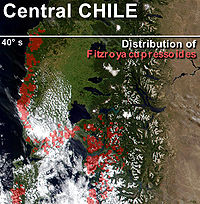Fitzroya
| Fitzroya | |
|---|---|
 |
|
| Fitzroya cupressoides | |
| Scientific classification | |
| Kingdom: | Plantae |
| Division: | Pinophyta |
| Class: | Pinopsida |
| Order: | Pinales |
| Family: | Cupressaceae |
| Genus: | Fitzroya |
| Species: | F. cupressoides |
| Binomial name | |
|
Fitzroya cupressoides I.M.Johnst. |
|
 |
|
| Distribution of F. cupressoides in South-Central Chile (red) | |
Fitzroya is a monotypic genus in the cypress family. The single living species, Fitzroya cupressoides, is a tall, long-lived conifer native to the Andes mountains of southern Chile and Argentina, where it is an important member of the Valdivian temperate rain forests. Common names include alerce ("larch" in Spanish), lahuán (Spanish, from the Mapuche Native American name lawal), and Patagonian cypress. The genus was named in honour of Robert FitzRoy.
F. cupressoides is the largest tree species in South America, normally growing to 40–60 m, but occasionally more than 70 m in Argentina, and up to 5 m in trunk diameter. Its rough pyramidal canopy provides cover for the southern beech, laurel and myrtle. The largest known living specimen is Alerce Milenario in Alerce Costero National Park, Chile. It is more than 60 m tall, with a trunk diameter of 4.26 m. Much larger specimens existed before the species was heavily logged in the 19th and 20th centuries; Charles Darwin reported finding a specimen 12.6 m in diameter.
The leaves are in decussate whorls of three, 3–6 mm long (to 8 mm long on seedlings) and 2 mm broad, marked with two white stomatal lines. The cones are globose, 6–8 mm in diameter, opening flat to 12 mm across, with nine scales in three whorls of three. Only the central whorl of scales is fertile, bearing 2–3 seeds on each scale; the lower and upper whorls are small and sterile. The seeds are 2–3 mm long and flat, with a wing along each side. The seeds mature 6–8 months after pollination.
...
Wikipedia

